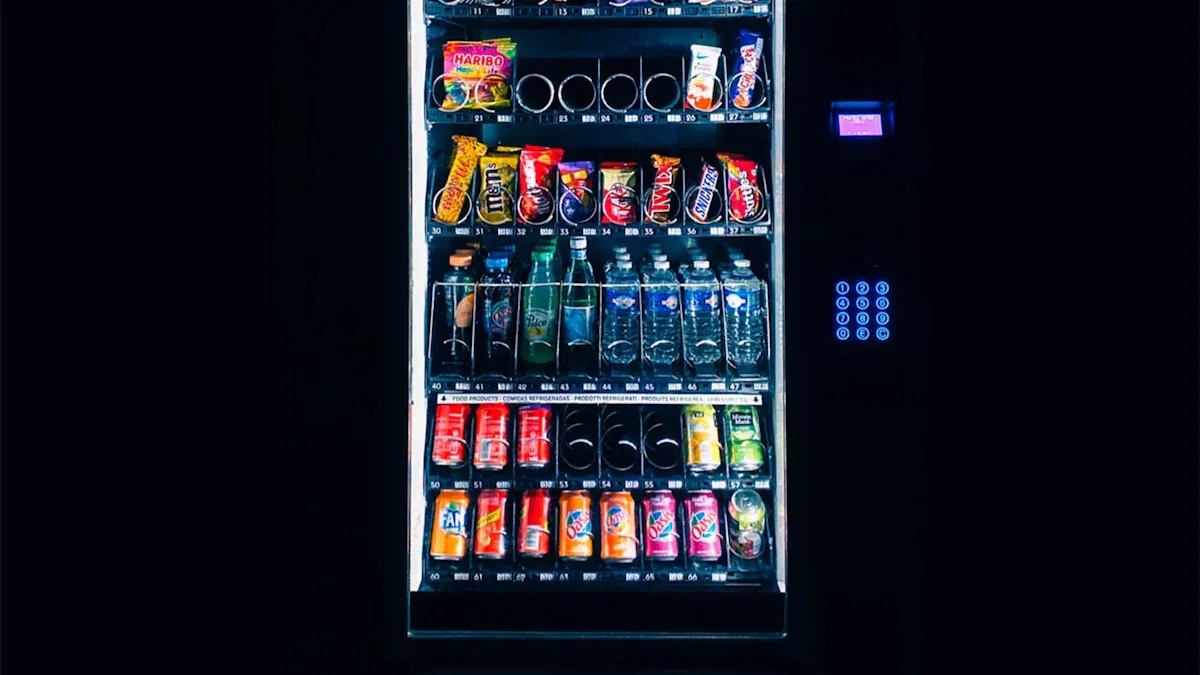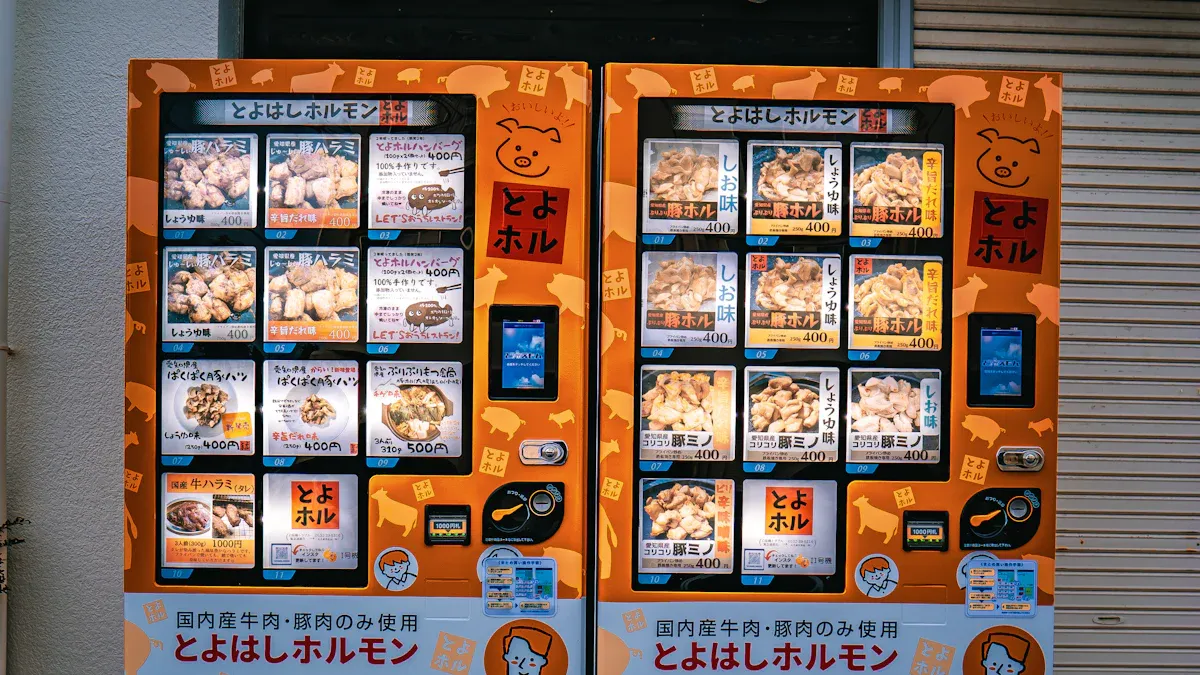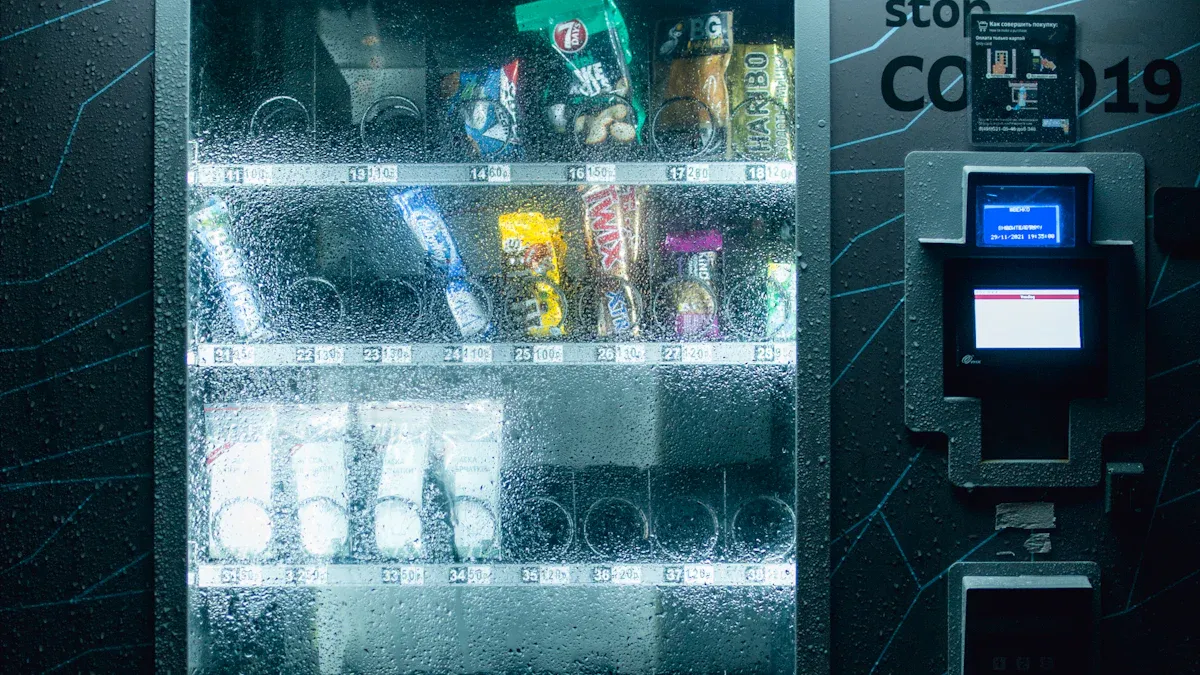Vending Machine Error Codes

You interact with a vending machine almost every day, but you may not realize that these machines have their own language. Vending machine error codes help you understand what is wrong when a vending machine stops working. These codes appear on the display when something needs attention. You can use vending machine error codes to find problems quickly and keep the vending machine running. When you know what these codes mean, you can solve issues before they turn into bigger problems. A working vending machine means happy customers and fewer complaints. If you learn how to read vending machine error codes, you make your vending machine more reliable.
Key Takeaways
Vending machine error codes show specific problems and help you fix issues quickly to keep the machine working.
Common errors include coin jams, door sensor problems, and cooling faults; knowing these codes saves time and money.
Follow a clear process to troubleshoot: identify the code, check the manual, inspect and clean the machine, then test it.
Regular cleaning and maintenance prevent errors and keep your vending machine reliable and safe for customers.
Call a professional if errors persist or you see serious signs like electrical smells or repeated complex codes.
Vending Machine Error Codes Overview
What Are Error Codes
When you use a vending machine, you might see numbers or letters pop up on the display. These are called error codes. Each code tells you about a specific problem inside the vending machine. For example, you might see a code if the coin slot gets jammed or if the door does not close all the way. You do not need to guess what is wrong. The vending machine gives you a clue with these codes.
You can think of vending machine error codes as a secret language. This language helps you find out what needs fixing. Some codes are simple, like a message that says the machine is out of change. Others might warn you about a bigger issue, such as a cooling problem. If you learn what these codes mean, you can solve problems faster.
Tip: Keep a list of common error codes near your vending machine. This makes it easy to check what each code means.
Why They Matter
You want your vending machine to work all the time. When you understand vending machine error codes, you can fix problems before they get worse. This saves you time and money. If you ignore a code, the vending machine might stop working. Customers will not be able to buy snacks or drinks. You might lose sales.
Here are some reasons why error codes matter:
They help you spot problems quickly.
You can fix small issues before they become big ones.
You keep your vending machine running smoothly.
You make sure customers stay happy.
If you pay attention to vending machine error codes, you keep your business strong. You also make sure your vending machine lasts longer.
Common Vending Machine Error Codes

Understanding vending machine error codes helps you solve problems fast. Each code points to a specific issue with vending machine parts. Here are some of the most common errors you might see:
Coin and Bill Errors
You may notice your vending machine not taking coins or bills. This often means there is a problem with the payment system. Common codes include:
E1: Coin jam. The coin path is blocked, so the vending machine won't dispense products.
E2: Bill jam. The bill acceptor is stuck or dirty, leading to a vending machine not taking bills.
CHUTE: Coin chute error. Coins are not moving through the chute correctly.
JAM TUBE: Coin tube jam. Coins are stuck in the storage tube.
If you see these codes, your vending machine may stop accepting payments and could become an out of service machine.
Sensor and Door Errors
Sensors and doors play a big role in vending machine operation. When sensors fail, you might see codes like:
SENSOR: Sensor malfunction. The machine cannot detect product movement or door status.
E3: Door open error. The door is not closed properly, or the sensor is faulty.
COMMUN: Communication error between vending machine parts.
A case study showed that after redesigning the sensor and door mechanisms, a vending machine passed 720 trays without failure. This shows how fixing these errors can improve reliability.
Temperature and Cooling Errors
Temperature control keeps products fresh. If you see these codes, act quickly:
E4: Cooling system fault. The machine cannot keep products cold.
DEF: Defrost error. The defrost cycle failed.
Extreme heat or cold can damage vending machine parts and spoil products. Control boards work best between 5°C and 35°C. Intelligent systems help keep the right temperature, so your vending machine out of stock problem does not happen due to spoilage.
EFL8 Error Code
The efl8 error code is unique. It often means a problem with the main control board or firmware. If you see the efl8 error code, your vending machine may display an out of service message. This code can stop all functions until you reset or repair the machine.
Always check the manual for specific steps when you see the efl8 error code. Some errors, like E1, E4, and efl8, can disable the vending machine and trigger an out of service machine alert.
Vending Machine Troubleshooting

Fixing Error Codes
You can solve many vending machine problems by following a clear process. Start by looking at the error code on the display. Each code points to a specific issue, such as a jam or a payment problem. Use these steps for effective vending machine troubleshooting:
Identify the Error Code
Read the code shown on the vending machine screen. Write it down if needed.Check the Manual
Look up the code in your vending machine manual. The manual explains what each code means and gives you instructions for fixing it.Inspect the Machine
If the vending machine won't dispense, open the door and check for stuck products or blocked coils.
For a vending machine not taking coins or a vending machine not taking bills, inspect the coin and bill acceptors. Remove any dirt, dust, or jammed coins and bills.
If you see a vending machine out of stock message, refill the products and make sure they are loaded correctly.
Clean and Maintain
Use a soft cloth to clean the coin and bill mechanisms. Dirt and grease can cause jams and errors.Test the Machine
After fixing the issue, close the door and test the vending machine. Try inserting coins or bills and select a product to see if the error is gone.
Tip: Keep a log of all maintenance activities. This helps you spot patterns and prevent future issues.
Resetting the Machine
Sometimes, a simple reset can clear error codes and restore normal operation. Many vending machine troubleshooting steps include a reset as a first action. Here is how you can reset most vending machines:
Power Cycle
Unplug the vending machine from the wall outlet. Wait for at least two minutes. Plug it back in and turn it on. This can clear many software glitches.Admin Mode Reset
Some machines have a control panel inside. Enter your machine ID and password to access admin mode. Use the menu to clear faults or reset the system.Card Reader Reset
If your vending machine uses a card reader, follow the manufacturer’s instructions to reset it. This often involves pressing a button sequence.Factory Override
For stubborn jams, use the factory override code in admin mode to release stuck products.
The table below shows how a reset can help with different error codes:
Error Code | Cause Summary | Reset-related Treatment |
|---|---|---|
0F3 | Field bus module not detected | Reboot power; replace controller if reboot fails |
0FB | FPGA malfunction | Turn power off and reboot; check noise; replace if needed |
0FC | Logic error from CPU malfunction | Reboot power; check noise; replace driver unit if needed |
0F0 | Driver logic error | Reboot power; consult manufacturer if issue persists |
090 | Software reset command issued in servo ON status | Ensure servo is OFF before issuing software reset command |
Note: Always follow safety guidelines when working with electrical equipment. If you feel unsure, ask for help.
When to Call for Help
You can fix many vending machine issues on your own, but some problems need expert attention. Call a professional if:
The same error code keeps coming back after you reset the machine.
You see complex codes like "efl8" or frequent software crashes.
The vending machine troubleshooting steps do not solve the problem.
You notice electrical smells, sparks, or signs of overheating.
Professional technicians have special tools and training. They can handle advanced repairs, update software, and replace faulty parts. Regular visits from a technician can also prevent future vending machine problems.
Reminder: Schedule regular maintenance checks. This keeps your vending machine running smoothly and reduces downtime.
Vending Machine Maintenance
Preventive Tips
You can keep your vending machine running smoothly by following simple preventive tips. Regular cleaning is one of the most important steps. Studies show that most machines get cleaned at least twice a week, which helps stop germs and keeps snacks safe. You should wipe down surfaces, clean the coin and bill slots, and remove any spills right away. Use a microfiber cloth for the outside and disinfectant wipes for buttons and payment areas. For the inside, choose food-safe cleaners to protect your products.
Wear clean clothes and keep your fingernails short when handling food or restocking.
Place your vending machine away from sources of dirt or moisture.
Use protective coatings or rust inhibitors on metal vending machine parts, especially if your machine sits in a humid spot.
Keep a maintenance kit with cleaning supplies and basic repair tools nearby.
Keeping your vending machine clean and well-placed can prevent rust, reduce breakdowns, and make your machine last longer.
Smart technology can also help. Devices like VendingMiser and VM2iQ lower energy use and protect the compressor, which means less wear on vending machine parts. Energy Star components and sensors can cut energy use by up to 40%, making vending machine maintenance easier and more cost-effective.
Regular Checks
You should check your vending machine on a regular schedule. Weekly tasks include cleaning the outside, checking payment systems, and testing if products drop correctly. Every few months, clean the coin mechanisms, replace air filters, and calibrate the cooling system. Once a year, do a deep clean, update software, and replace worn vending machine parts.
Clean and inspect all surfaces and payment slots weekly.
Calibrate refrigeration and change filters every quarter.
Deep clean and update software yearly.
Regular checks help you find problems early. This prevents most breakdowns and keeps your vending machine working for your customers. Remote monitoring tools can alert you to issues before they become serious, so you can fix them quickly and avoid downtime.
You play a key role in keeping your vending machine running smoothly. When you understand vending machine error codes, you solve problems before they grow. Regular vending machine maintenance helps you avoid breakdowns and keeps customers happy. Use this guide to troubleshoot your vending machine and fix issues fast. Save these tips for future vending machine care. If your vending machine shows stubborn errors, reach out to a professional. Your vending machine will last longer with the right attention.
FAQ
What should you do if your vending machine displays an error code you do not recognize?
Check the manual for your vending machine. If you cannot find the code, contact the manufacturer or a service technician. You should never ignore unknown codes because they can signal bigger problems.
How often should you clean your vending machine to prevent errors?
Clean your vending machine at least twice a week. Wipe down surfaces, clear the coin and bill slots, and remove any spills. Regular cleaning helps prevent jams and keeps your vending machine working well.
Can you reset a vending machine yourself if it stops working?
Yes, you can reset most vending machines by unplugging them for two minutes and plugging them back in. This simple step often clears minor faults and restores normal operation.
Why does your vending machine sometimes stop accepting coins or bills?
Dirt, jams, or worn parts can cause payment problems. You should inspect the coin and bill acceptors, clean them, and remove any stuck items. If the problem continues, you may need to replace faulty parts.
What is the best way to keep your vending machine running smoothly?
Perform regular maintenance. Clean the machine, check for jams, and refill products on schedule. Keep a log of all repairs and inspections. This routine helps you avoid breakdowns and keeps your vending machine reliable.
See Also
Understanding The Expenses Involved With Vending Machines
Pricing Factors For Tailored Vending Machine Solutions
How Much Do Vending Machine Permits Typically Cost
Exploring The World Of Collectible Vending Machines Today
Detailed Analysis Of Features Influencing Vending Machine Prices
